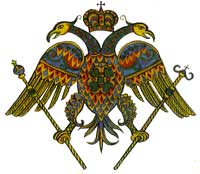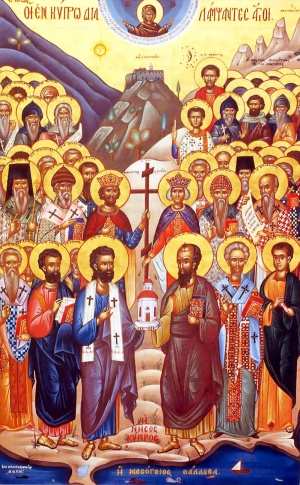Church of Cyprus
| Church of Cyprus | |
| Founder(s) | St. Barnabas |
| Autocephaly/Autonomy declared | 431 |
| Autocephaly/Autonomy recognized | 478 |
| Current primate | Abp. Chrysostomos II |
| Headquarters | Nicosia, Cyprus |
| Primary territory | Cyprus |
| Possessions abroad | — |
| Liturgical language(s) | Greek |
| Musical tradition | Byzantine Chant |
| Calendar | Revised Julian |
| Population estimate | 500,000 |
| Official website | Church of Cyprus |
The Greek Orthodox Church of Cyprus is one of the autocephalous churches of the Orthodox Christian communion whose territory consists of the island of Cyprus in the Mediterranean Sea. Although through the centuries the island has been occupied by various parties, the church has retained its independence. The current primate is Archbishop Chrysostomos II of Nea Justiniana and All Cyprus.
Contents
History
Christianity was originally brought to Cyprus by the Apostles Barnabas and Mark in the first century, c. 46AD and was under the jurisdiction of the Patriarchate of Jerusalem until 325. Apostle Barnabas is considered to be the first bishop of Cyprus. Its autocephaly was established at the Council of Ephesus in 431, overriding the claims of the Patriarch of Antioch.
In 478, the grave of St. Barnabas was found, with a copy of the Gospel of Matthew on his relics. The autocephaly of the Church of Cyprus was confirmed later that year by the Roman Emperor Zeno who granted its Archbishop "three privileges," that is: to sign his name in cinnabar, to wear purple instead of black under his vestments, and to use an imperial scepter instead of the episcopal crosier.
The Arab invasions of the seventh century forced the Archbishop to flee the island to Hellespont, where under the protection of Emperor Justinian II he established a new city called Nova Justiniana (now "Nea Justiniana") in honor of the emperor. In 698, the Arabs were driven out of Cyprus and the Archbishop returned to the island, but retained the title of Archbishop of Nova Justiniana and All Cyprus. With the occupation of Cyprus by the Crusades from 1191 to 1571, the Orthodox hierarchy found itself subordinated to the occupying Latin French and Venetian kings, who forced a reduction in the number of Orthodox bishops from 14 to four. Additionally, the Latin bishops attempted to gain concessions on the differences in doctrine and practices between the two churches.
The occupation of Cyprus by the Ottomans from 1571 to 1832, resulted in return of privileges to the Orthodox which they had previously had, but in an environment that was insecure, and under which their lives and property were always at the disposal of the Ottomans. Under the Ottoman ruling practices, the Christian populace of Cyprus (Rum millet) was considered a separate nation with the Orthodox church the only legal Christian church. They considered the Archbishop to be the political head of this Christian nation, with responsibility for collecting taxes. The news of the revolution for Greek independence in 1821 resulted in the death of Archbishop Kyprian and many other members of the Cyprian Orthodox hierarchy, clergy, and laity.
In 1878, after the British assumed control of Cyprus, the Church gained more freedom in her religious practices, including a return to the use of the bells in the churches. Yet the British interfered seriously in church activities, resulting in an uprising by the Church in October 1931, after which the British imposed additional restrictions on election of the Archbishop. The British occupation lasted until 1960 when Cyprus regained its independence with the election of Archbishop Makarios as the head of state of Cyprus as well as being the head of the Church. This unique combination continued until his death in 1977.
As a consequence of an attempted military coup in 1974, Turkey invaded and occupied about a third of the island, forming an independent government, with almost all Orthodox moving to the remaining Greek portion of the island. Since then within the Turkish occupied part of the island, Orthodox property has sustained substantial damage. The Turkish occupied territories contain 514 churches, chapels, and monasteries.
Structure
Holy Archbishopric, Lefkosia
- His Beatitude the Archbishop of Cyprus Chrysostomos II, seat Nicosia.
- Bishops:
- His Grace Christoforos, Bishop of Karpasia.
- His Grace Porfyrios, Bishop of Neapolis.
- His Grace Gregorios, Bishop of Mesaoria
Holy Bishopric of Paphos/Holy Metropolis of Paphos
- Most Reverend Georgios, Metropolitan of Paphos, seat Paphos.
- Bishop:
- His Grace Nektarios, Bishop of Arsinoi.
Holy Bishopric of Kitiun/Holy Metropolis of Kitium
- Most Reverend Chrysostomos, Metropolitan of Kition, seat Larnaca.
Holy Bishopric of Keryneia/Holy Metropolis of Kyreneia
- Most Reverend Pavlos, Metropolitan of Kyreneia, seat Kyreneia.
- Due to the Turkish occupation of Keryneia, the Holy Bishopric of Keryneia, since 1974, is temporarily located in Lefkosia.
Holy Bishopric of Lemesos/Holy Metropolis of Lemessou
- Most Reverend Athanasios, Metropolitan of Limassol, seat Limassol.
- Bishop:
- His Grace Nikolaos, Bishop of Amathus.
Holy Bishopric of Morphou/Metropolis of Morphou
- Most Reverend Neophytos, Metropolitan of Morphou, seat Morphou.
- Due to the Turkish occupation of Morfou, the Holy Bishopric of Morfou is temporarily located at Evrychou village.
Holy Bishopric of Konstantia/Holy Metropolis of Konstantias
- Most Reverend Vasilios, Metropolitan of Konstantia-Ammochostos, seat Ammochostos.
- Due to the Turkish occupation of Ammochostos (Famagusta) the Holy Bishopric of Kostantia is temporarily located in Paralimni.
Holy Bishopric of Kykkos and Tylliria/Holy Metropolis of Kykkos and Tillyrias
- Most Reverend Nikiforos, Metropolitan of Kykkos and Tylliria, seat Kykkos Monastery.
- Holy Monastery of Kykkos, Troodos.
Holy Bishopric of Tamasos and Orinis/Holy Metropolis of Tamasos
- Most Reverend Isaias, Metropolitan of Tamasos and Orinis, seat Deftera.
Holy Bishopric of Tremithus/Holy Metropolis of Tremithus
- Most Reverend Varnavas, Metropolitan of Tremithus, seat Idalion.
Holy Monastery of Kykkos
- Abbot: Most Reverend Nikiforos, Metropolitan of Kykkos and Tylliria.
Holy Monastery of Machairas
- Abbot: Right Reverend Epiphanios, Bishop of Ledra.
Holy Monastery of Agios Neophytos
- Abbot: Right Reverend Leondios, Bishop of Chytroi.
Holy Monastery of Apostle Barnabas
- Abbot: Very Reverend Archimandrite Gabriel.
Hierarchical Succession of the Archbishopric See of Cyprus
See List of Archbishops of Cyprus.
Local saints
The official website for the Church of Cyprus[1] lists approximately sixty local saints.
The most famous of these is Apostle Barnabas (June 11) and Lazarus.
| Autocephalous and Autonomous Churches of Orthodoxy |
| Autocephalous Churches |
| Four Ancient Patriarchates: Constantinople · Alexandria · Antioch · Jerusalem Russia · Serbia · Romania · Bulgaria · Georgia · Cyprus · Greece · Poland · Albania · Czech Lands and Slovakia · OCA* · Ukraine* |
| Autonomous Churches |
| Sinai · Finland · Estonia* · Japan* · China* · Ukraine* |
| The * designates a church whose autocephaly or autonomy is not universally recognized. |
Published Works
- Annemarie Weyl Carr. Byzantines and Italians on Cyprus: Images from Art. Dumbarton Oaks Papers. Vol.49, Symposium on Byzantium and the Italians, 13th-15thCenturies. 1995. pp.339-357.
Reference
Source
External links
- Orthodox Church of Cyprus, official site
- Eastern Christian Churches: Orthodox Church of Cyprus, a scholarly text by Ronald Roberson, CSP, a Roman Catholic priest and Eastern Christianity scholar
- Cypriot Government site
- Wikipedia:Cypriot Orthodox Church
- Apostolic Successions

